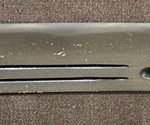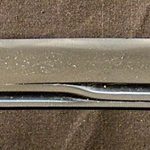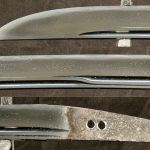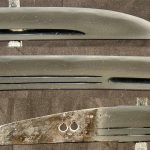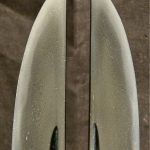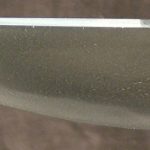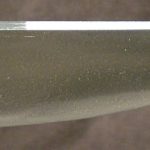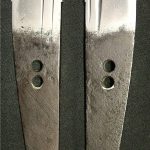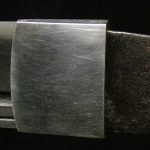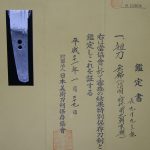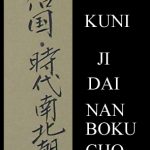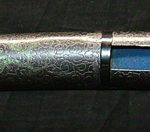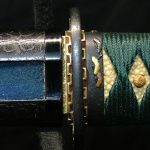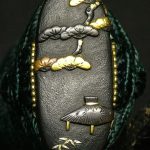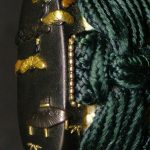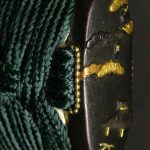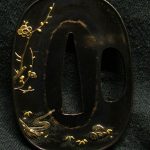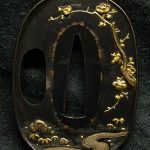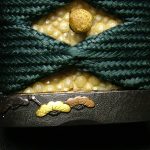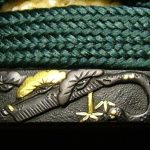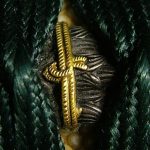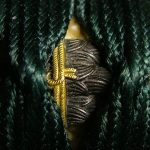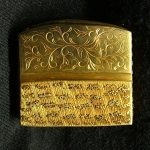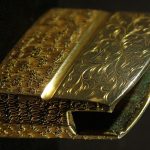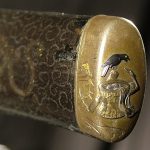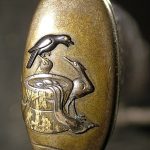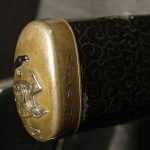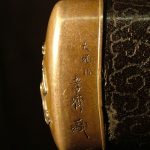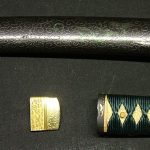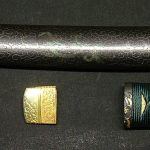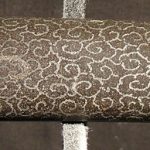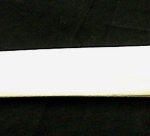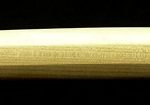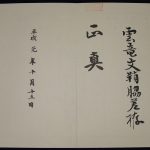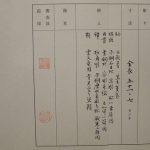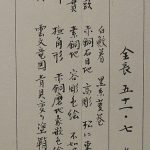NOBUKUNI TANTO / NAMBOKUCHO JIDAI
NOBUKUNI
TANTO
NAMBOKUCHO PERIOD c. 1390
YAMASHIRO RAI
NBTHK TOKUBETSU HOZON
SUGATA: HIRA ZUKURI
MEI: MUMEI (ATTRIBUTED): NOBUKUNI
DATE (ATTRIBUTED): LATE NAMBOKUCHO (1333-1393)
NAGASA: 30.0cm (11.8125″)
OVERALL: 38.2cm (15.065″)
MIHABA: 3.02cm (1.875″)
KASANE: 0.476cm (0.1875″)
SORI: 0.476cm (0.1875″)
NAKAGO: UBU
MEKUGI ANA: TWO
YASURIME: SUJIKAI
MUNE: IORI
HADA: KO-ITAME
HAMON: NOTARE
BOSHI: KOMARU
HORIMONO OMOTE: YES
HORIMONO URA: YES
HABAKI: ONE PIECE SILVER FOIL (SHIRASAYA)
ONE PIECE GOLD FOIL (KOSHIRAE)
SHIRASAYA / KOSHIRAE
TANTO
NOBUKUNI
NAMBOKUCHO PERIOD c. 1390
YAMASHIRO RAI
TOKUBETSU HOZON
Most will recognize the name Nobukuni, as an important one. There are several schools of thought on identifying the specific generations of Nobukuni smiths, especially in the Nambokucho era. This is related to the historical records being unclear regarding the precise succession following the Shodai Nobukuni. I will provide a brief synopsis of the main theories, but keep in mind it is open to debate.
Even the authorities / scholars of the past as well as today, the NBTHK, NTHK have difficulty discerning the generations, again related to unclear records. In most instances the works of Nobukuni smiths are papered or attributed to a time period or era opposed to a specific generation.
The Nobukuni Ichiryu school has its roots in the Yamashiro Rai School, that much is certain.
The Shodai Nobukuni is said to be either the son of Ryokai or possibly the son of Ryo Hisanobu or Kunihisa, either of which would make him the grandson of Ryokai. Ryokai being the son of either Niji Kunitoshi or Rai Kunitoshi. The Shodai Nobukuni it is written, first signed Nobuhisa and changed his name to Nobukuni around Kenmu (1334-1336), yet there are no extant works from this period.
Shodai Nobukuni was said to have been one of the three Soshu Sadamune Santetsu (Three disciples of Sadamune).
________________________________
The Toko-Taikan dates the Shodai to the Kenmu era (1334-1336) and says that he was the son of Ryo Hisanobu. It says also that there exists the theory that he was the son of Hisanobu’s younger brother Kunihisa and that he signed first with Nobuhisa. Another theory says that he was the nephew of Hisanobu. Further, the oldest extant date signatures is Enbun three (1358) and there are no extant signed blades which could be dated back to the Kenmu era.
This led to the theory that the Shodai was actually active around Enbun (1356-1361).
The Nidai was the legitimate son of the Shodai and the grandson of Ryoi Hisanobu and supposedly active around the Enbun era. Due to the fact that there are no signed works which can be attributed to the Shodai in the Kenmu era, some scholars believe the previously referred to Nidai (Enbun) is actually the Shodai. He is at times referred to as “Enbun-Nobukuni”.
The Sandai was active around Shitoku (1384) and there exists also a date signature from the third year of Meio (1392). Counting the semi-legendary Kenmu-Nobukuni as Shodai, he is the Sandai. If Enbun-Nobukuni was the actual Shodai, then this Nobukuni would be the Nidai.
_____________________________________
* Albert Yamanaka relates, the Nidai followed very closely upon the time of the Shodai and their production times overlapped. Their workmanship and quality is very similar with only subtle differences in the mei. Works attributed to the Nidai date from the Oan era 1368, to the beginning of Oei 1394.
____________________________________
** The Nihonto Koza states the Shodai was from the Kenmu era, but again works remain nonexistent. As such those works from Enbun (1356-1361) and Joji(1362-1368) are considered to be the Shodai and those from Oan 1368 to Oei 1394 are considered the Nidai. Later works from the Oei period, the beginning of the Muramachi period, to Eikyo1429 to be the Sandai.
____________________________________
*** Fujishiro states, Considering the fact the oldest dated blade is from the Joji era(1362), the Shodai Kenmu Nobukuni is thought to be an example of “Moving back the era”. This Nobukuni(joji 1362) is viewed as the Shodai. It is known this smith was in the “Rai” Ha, as his family name was Minamoto, as was Rai Kunitoshi and Rai Kunimitsu.
____________________________________
This particular Tanto has received Tokubetsu Hozon papers from the NBTHK which state with certainty “Late Nambokucho”.
Keep in mind the beginning of Enbun 1356 to the beginning of Oei 1394 is only 38 years. In such a short time frame more than one generation’s work could easily overlap. It seems most likely to me that this tanto is the work of the Nidai Nobukuni. However, depending on which theory is correct it could easily be the Shodai. Confused yet ?
If the NBTHK can’t pinpoint it, I sure as hell can’t. Here is what is certain.
The blade itself is in great condition for a sword made in the late 1300’s. It does have a few small kizu which are clearly seen in the photos. There is no damage or anything detrimental to the sword.
There is so much to see and enjoy in this sword. There are hi carved on both sides. The hada is a a gorgeous itame with areas of mokume, a profusion of chikei, ji-nie and utsuri. The hamon is notare and there are sunagashi and kinsuji with ko-nie sprinkled lightly along the ha.. The nakago is ubu with two mekugi ana. The tanto has a one-piece silver habaki and is in shirasaya.
*Please note: the light reflects dramatically from these small areas and looks worse in the photos than in hand.
The Tanto is accompanied by a beautiful koshirae which received a 75pt kanteisho from the NTHK. The Kojiri is signed “Daryuson Kosai (kao), which was the studio name of Tsuchiya Toshichika. The kojiri is shibuichi and depicts a crow and a heron at a washtub.
The saya is a black lacquer cloud motif with dragons done in crushed green abalone shell. The kurigata, koiguchi, and aragawara are horn. There is no kozuka, and there is no kogatana slot on the koshirae.
The tsuba as well as the fuchi/kasira are shakudo with takobori inlays of gold, silver, and copper depicting forest/floral scenes.
Menuki are shakudo and depict bamboo shoots wrapped in gold rope.
Habaki is a fine as they come, a gold foil with exquisite scroll carvings.
Koshirae comes with a wooden tsunagi blade to hold it together for display.
600+ year old NOBUKUNI Tanto with NBTHK TOKUBETSU HOZON papers, and a 75pt NTHK papered KOSHIRAE.
$7,500 plus S/H
For purchase or inquiries contact me at either:
Yakiba.com@gmail.com
Yakiba1@yahoo.com
